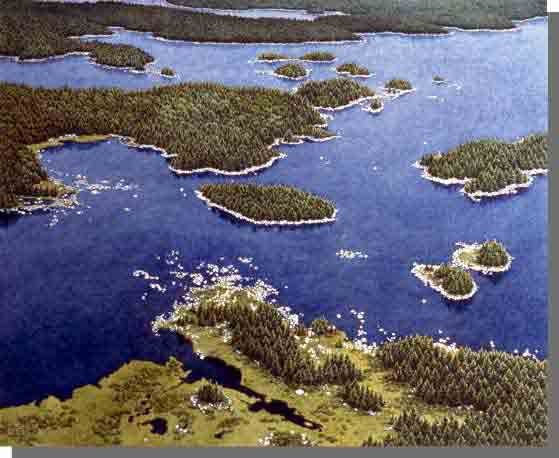 Tangier Grand Lake Wilderness Area protects over 16,000 hectares of rugged, conifer forest wilderness, richly endowed with lakes, waterways and wildlife. Located in the eastern portion of Halifax Regional Municipality, between Ship Harbour and Mooseland, this near-coastal wilderness is well known for its trout fishing and canoe-tripping opportunities.
Tangier Grand Lake Wilderness Area protects over 16,000 hectares of rugged, conifer forest wilderness, richly endowed with lakes, waterways and wildlife. Located in the eastern portion of Halifax Regional Municipality, between Ship Harbour and Mooseland, this near-coastal wilderness is well known for its trout fishing and canoe-tripping opportunities.
The area is typical of Nova Scotia's Eastern Shore Granite Ridge natural landscape. Its rugged, lake-pocked character tells a tale of glaciation, which ended only 10-12,000 years ago. Thick ice sheets scraped across the resistant, 350 million year old granite bedrock, carving out dozens of lake-filled depressions; rough, parallel ridges and knobs; undulating, bouldery terrain; and deposits of glacial debris. Tangier Grand Lake is a prominent feature of the area and is the largest of Nova Scotia's lakes which does not have direct road access.
The area's expansive spruce, white pine and balsam fir forest is interrupted by barrens, bogs, and many lakes and waterways. Scattered, glacier-formed hills with deeper and richer soils support hardwoods, such as yellow birch and sugar maple. Hemlock also occurs locally, mixed with spruce and pine - in some cases forming stands 120 or more years of age.
The Mi'kmaq named this region of Nova Scotia 'Wospegeak,' meaning 'sunshine is reflected from water'. Such description aptly suits Tangier Grand Lake Wilderness Area. Its abundant lakes and waterways are enjoyed by anglers and canoe adventurers. Ancient, traditional waterway routes can be followed well beyond the area's boundaries.
About a half-dozen campsite leases occur within the wilderness area.
Tangier Grand Lake Wilderness Area was expanded by nearly 170 hectares in 2015 to better protect three lakes along its southern boundary.

